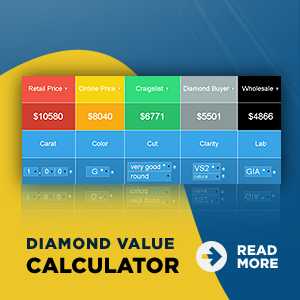The diamond is an atomic crystal whose carbon are held together in a strong and rigid lattice.
 diamond
diamond
 graphite
graphite
This accounts for the diamond’s extreme hardness and resistance to deformation but the fact that the carbon atoms are not packed closely together means the diamond possesses a very high degree of thermal conductivity. The density of the atomic structure varies directionally and this is why the diamond is harder than in others. In fact it it the nature of crystal lattice that provides the diamond with many of its unique physical properties and split into the colors of spectrum, the greater the amount of fire a stone is said to have. It is the job of the diamond cutter to achieve a fine balance between the fire and life of a diamond, as maximum fire is not consistent with maximum “life”. The early cutters were well aware of theses qualities. As the Sir John Mandeville Lapidary observed in 1561, the diamond “seems to take pleasure in assuming in turn the colors proper to other gems.”
A further distinguishing feature of many diamonds is that they will glow or fluoresce when exposed to ultraviolet light; they may also phosphoresce, or continue to glow, after the removal of the light source. Every diamond is different both in the color and intensity of its fluorescence and phosphorescence, a fact which can make for positive identification of two apparently identical stones of pieces of jewelry. The Hope diamond, which is blue, fluoresces red, for example; while the Maximilian, which is also blue, fluoresces violet even in daylight.
However, despite this unique catalogue of the optical attributes possessed by the diamond, the fact remains that in the rough state in which it is found, a diamond is often not recognized for what it is. It does not sparkle and flash. On the contrary, it is a rather dull, ordinary-looking pebble whose principal distinguishing feature is its shape. The reason is that many diamond crystals are coated with a thickness of inferior quality and badly formed diamond. The coating may be gray, green, brown or black and is usually found to contain many small inclusions of foreign material. It is not necessarily indicative of the standard of the rest of the stone and a highest quality–or one almost as dull and dirty as itself.
Diamonds, like most minerals, are crystalline with a regular internal structure that is not necessarily reflected in the external form. Growth occurs in layers but it is by no means uniform. Some faces may be underdeveloped and others overdeveloped; the whole crystal may be change its orientation during growth; or two or more crystals may grow locked together. As a result the diamond appears in many more forms than is suggested by the popularly depicted eight-sided crystal called an octahedron. It appears in other single crystal shapes as well as in formless crystalline masses.
 octahedron
octahedron
Of the seven main systems of symmetry into which crystals are divided, diamond falls into the cubic system, the most symmetrical of all. The possible forms of regularly shaped diamond crystal.
The octahedron is the most common of these crystals of regular shape. Even more common than the octahedron, however, are the pieces of no recognizable form. These may be distorted crystals or pieces that have been broken or worn into irregular shapes. It is these diamonds that provide the real challenge to the cutter. Once he has studied them and found the crystal directions, he can often make a higher recovery than he would on a regular crystal. The huge Cullinan was such a stone.
There are literally thousands of divisions into which rough diamonds could be classified as they come from the mines, but in order to simplify the process they are restricted to four main shapes. In order of value and importance to the gem cutter, they are as follow:
1. Stones-unbroken crystals of regular formation.

2. Cleavages-broke or irregularly formed pieces.

3. Macles-twinned crystal, flat and triangular in form

4. Flats-irregularly shaped pieces with flat parallel sides.

This is the practical working division and, of course, it cuts right across any academic or scientific one based on ideal crystal types. The classification of diamonds already mentioned refer only to gem crystals, but since 80 percent of production is destined for industrial use, there is a broader grouping that divides diamonds into:
1. Gem diamonds
2. Industrial stones, including:
A)shaped stones
B)whole stones
C)borts
The difference between gem and industrial diamonds is purely one of quality and color. The imperfections that affect quality and color may take the form of fractures or fissures or of minute inclusions of other minerals that were present in the original magma when the diamond was formed. The most popular shape for the gem cutter is the octahedron. For industrial use, the dodecahedron and other more rounded crystals are generally preferred, although octahedrons are still regarded as more suitable for use as truing diamonds for shaping grinding wheels and for setting in the tips of rock drills. Irregularly shaped stones are usually used as glass cutters’ diamonds and for setting in stone saws.
 bort
bort
Bort (an early Afrikaans word for “bastard”) is a minutely crystallized gray or black diamond mass which is not usable in individual crystals for any industrial application. It is therefore crushed to powder for grinding and polishing purposes. Boart has its own numerous classifications, one of the most interesting of which is ballas or shot boart. This is found in the shape of a ball and with no crystalline faces or edges and no lines of cleavage, it is virtually indestructible. The Brazilian name for boart is carbonado.
It would be a mistake, however, to think that bort or carbonado is dull and uninteresting. There was a case in 1927 of what was apparently a 33-carat piece of boart being found to contain a small red diamond of exceptional quality at its heart. It eventually produced a 5.05-carat gem when cut. On rare occasions boart exists in a form that enables it to be cut to create a truly unique gem.

The best-known black diamond is the celebrated Black Orlov, a 67.5-carat stone cut out from a 195-carat rough of Indian origin. But a better and much more recent example is the beautiful stone known as the Amsterdam. While the Orloff is more of dark gun-metal color and partly translucent, the Amsterdam is totally black and impervious to light. The stone arrived at the offices of D. Drukker and Sons in Amsterdam in 1972 in a parcel of mine boart destined to be crushed into diamond powder or to be broken up into smaller pieces for other industrial purposes. At the time the 55.85-carat rough would have been valued at no more than $5-6 a carat. Drukkers tried to cleave the stone and immediately became aware both of its exceptional hardness and of the fact that the splinters were not in the least transparent, but of the deepest black. They decided to proceed with cutting and polishing the stone. The result is the pear-shaped 145-facet black diamond weighing 33.74 carats, one of the rarest gems in the world. Both the Amsterdam and Black Orlov dramatically underline the fact that the diamond is unique in all many forms.








